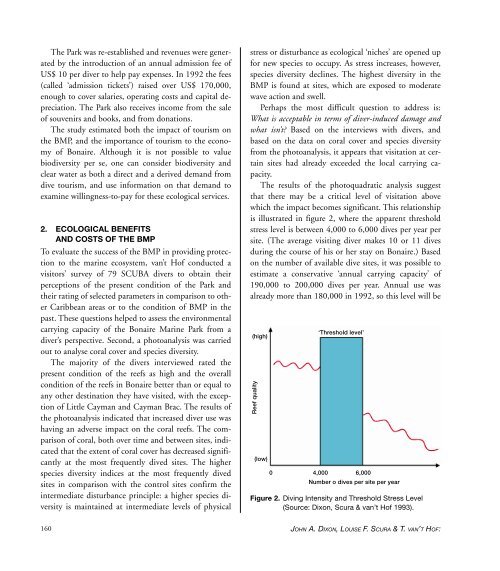Create successful ePaper yourself
Turn your PDF publications into a flip-book with our unique Google optimized e-Paper software.
The Park was re-established and revenues were generated<br />
by the introduction <strong>of</strong> an annual admission fee <strong>of</strong><br />
US$ 10 per diver to help pay expenses. In 1992 the fees<br />
(called ‘admission tickets’) raised over US$ 170,000,<br />
enough to cover salaries, operating costs and capital depreciation.<br />
The Park also receives income from the sale<br />
<strong>of</strong> souvenirs and books, and from donations.<br />
The study estimated both the impact <strong>of</strong> tourism on<br />
the BMP, and the importance <strong>of</strong> tourism to the economy<br />
<strong>of</strong> Bonaire. Although it is not possible to value<br />
biodiversity per se, one can consider biodiversity and<br />
clear water as both a direct and a derived demand from<br />
dive tourism, and use information on that demand to<br />
examine willingness-to-pay for these ecological services.<br />
2. ECOLOGICAL BENEFITS<br />
AND COSTS OF THE BMP<br />
To evaluate the success <strong>of</strong> the BMP in providing protection<br />
to the marine ecosystem, van’t H<strong>of</strong> conducted a<br />
visitors’ survey <strong>of</strong> 79 SCUBA divers to obtain their<br />
perceptions <strong>of</strong> the present condition <strong>of</strong> the Park and<br />
their rating <strong>of</strong> selected parameters in comparison to other<br />
Caribbean areas or to the condition <strong>of</strong> BMP in the<br />
past. These questions helped to assess the environmental<br />
carrying capacity <strong>of</strong> the Bonaire Marine Park from a<br />
diver’s perspective. Second, a photoanalysis was carried<br />
out to analyse coral cover and species diversity.<br />
The majority <strong>of</strong> the divers interviewed rated the<br />
present condition <strong>of</strong> the reefs as high and the overall<br />
condition <strong>of</strong> the reefs in Bonaire better than or equal to<br />
any other destination they have visited, with the exception<br />
<strong>of</strong> Little Cayman and Cayman Brac. The results <strong>of</strong><br />
the photoanalysis indicated that increased diver use was<br />
having an adverse impact on the coral reefs. The comparison<br />
<strong>of</strong> coral, both over time and between sites, indicated<br />
that the extent <strong>of</strong> coral cover has decreased significantly<br />
at the most frequently dived sites. The higher<br />
species diversity indices at the most frequently dived<br />
sites in comparison with the control sites confirm the<br />
intermediate disturbance principle: a higher species diversity<br />
is maintained at intermediate levels <strong>of</strong> physical<br />
stress or disturbance as ecological ‘niches’ are opened up<br />
for new species to occupy. As stress increases, however,<br />
species diversity declines. The highest diversity in the<br />
BMP is found at sites, which are exposed to moderate<br />
wave action and swell.<br />
Perhaps the most difficult question to address is:<br />
What is acceptable in terms <strong>of</strong> diver-induced damage and<br />
what isn’t Based on the interviews with divers, and<br />
based on the data on coral cover and species diversity<br />
from the photoanalysis, it appears that visitation at certain<br />
sites had already exceeded the local carrying capacity.<br />
The results <strong>of</strong> the photoquadratic analysis suggest<br />
that there may be a critical level <strong>of</strong> visitation above<br />
which the impact becomes significant. This relationship<br />
is illustrated in figure 2, where the apparent threshold<br />
stress level is between 4,000 to 6,000 dives per year per<br />
site. (The average visiting diver makes 10 or 11 dives<br />
during the course <strong>of</strong> his or her stay on Bonaire.) Based<br />
on the number <strong>of</strong> available dive sites, it was possible to<br />
estimate a conservative ‘annual carrying capacity’ <strong>of</strong><br />
190,000 to 200,000 dives per year. Annual use was<br />
already more than 180,000 in 1992, so this level will be<br />
(high)<br />
Reef quality<br />
(low)<br />
‘Threshold level’<br />
0 4,000 6,000<br />
Number o dives per site per year<br />
Figure 2. Diving Intensity and Threshold Stress Level<br />
(Source: Dixon, Scura & van’t H<strong>of</strong> 1993).<br />
160<br />
JOHN A. DIXON, LOUISE F. SCURA & T. VAN’T HOF:


















